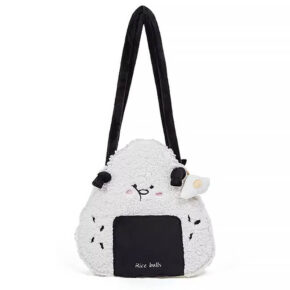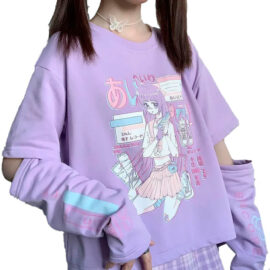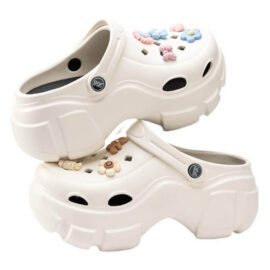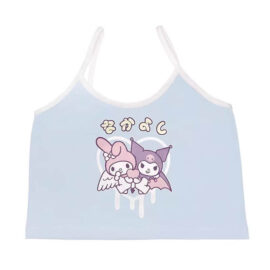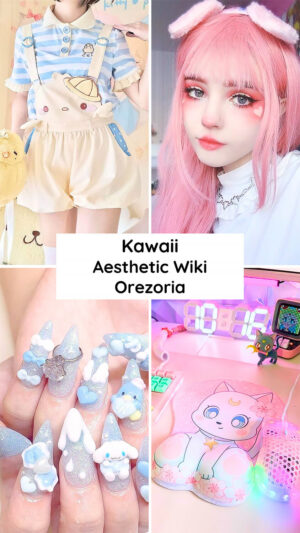
The Kawaii Aesthetic is a visual style that celebrates all things adorable and cute. Originating in Japan, it has had a wide influence on various aspects of life, from fashion to popular culture. The word “kawaii” itself translates to “cute” or “adorable” and is used to describe anything that exudes a charming and endearing quality.
Visual characteristics play a significant role in the Kawaii Aesthetic. Pastel colors, such as soft pinks and baby blues, dominate the color palette, creating a dreamy and whimsical atmosphere. Cute motifs are also prevalent, with sweet treats like ice cream cones and cupcakes, as well as nature-inspired elements like flowers and animals, serving as popular visual themes.
The Kawaii Aesthetic has become a global phenomenon, captivating people of all ages and backgrounds. It has permeated popular culture, influencing fashion trends, consumer products, and even fictional characters. From manga and anime characters to adorable items like plush toys and accessories, Kawaii has made its mark on the world.
In conclusion, the Kawaii Aesthetic is a celebration of all things adorable and cute. With its visual characteristics and wide influence, it has become a beloved part of popular culture, spreading joy and charm wherever it goes. Originating in Japan, this captivating aesthetic continues to enchant people around the world.
Related aesthetics: 2K Animecore, Animecore, Babygirl, Cute, E-Girl, Harajuku, Kidcore, Lolita, Pastel, Quackcore
Full List of Aesthetics
The Meaning and Origins of the Word Kawaii
The word “kawaii” originates from Japan and holds a unique cultural significance. Derived from the phrase “kawaisou,” meaning “pitiful” or “pathetic,” kawaii initially referred to an overwhelming feeling of empathy or compassion. Over time, its meaning evolved to represent something adorable, cute, or lovable.
In Japanese culture, kawaii has become a powerful symbol, reflecting a positive and lighthearted outlook on life. It serves as an escape from the societal pressures and demands faced by individuals. The concept of kawaii emphasizes embracing innocence, playfulness, and childlike qualities.
Kawaii characters, both fictional and real, have a significant presence in Japanese society. Manga and anime characters like Hello Kitty and Pikachu have become global icons of cuteness. Kawaii culture extends to fashion, with lolita fashion and fairy kei showcasing the influence of adorable aesthetics. Kawaii fashion often involves pastel colors, frills, and accessories that create a youthful and whimsical style.
In different aspects of Japanese society, kawaii has made its mark. From school girls charming with their chubby cheeks to the widespread use of cute mascots in marketing and advertising, the kawaii phenomenon is deeply rooted. Kawaii has even influenced the writing style, known as “burikko ji,” which involves expressing oneself using innocent and childlike language.
The kawaii aesthetic goes beyond superficial cuteness. It represents a mindset that values positivity, innocence, and finding happiness in the simple and adorable things of life. Its cultural impact cannot be understated, as kawaii continues to captivate people worldwide with its irresistible charm.
The History of Kawaii Aesthetic
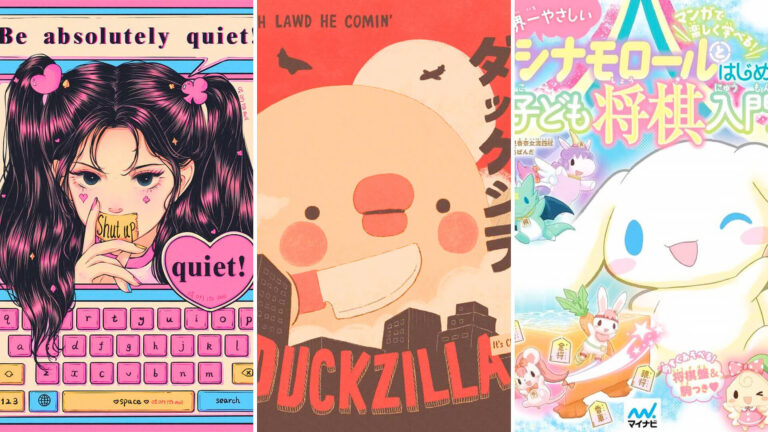
The history of the Kawaii Aesthetic is a fascinating journey that spans several decades, reflecting the evolution of Japanese society and culture. The word “kawaii” itself has undergone transformations, originally meaning “scary” or “terrifying” in the Heian period (794-1185). Over time, it took on additional meanings such as “shy”, “lovable”, and “adorable” during the Edo period (1603-1868).
However, it wasn’t until the 1970s that the Kawaii Aesthetic as we know it today began to emerge. In response to the strict societal expectations and traditional norms of post-World War II Japan, the youth started embracing and celebrating all things cute and whimsical. This newfound fascination with cuteness was seen as a form of rebellion against the rigid adult world.
One of the key milestones in the development of the Kawaii Aesthetic was the introduction of the character Hello Kitty by Sanrio in 1974. This small, innocent-looking kitten quickly captured the hearts of Japanese teenagers, and soon became a global icon of cuteness. Another influential moment was the rise of shōjo manga (girls’ comics) in the 1980s, which introduced countless cute and lovable characters.
The influence of Kawaii culture continued to grow in the following decades, permeating various aspects of Japanese society. From clothing and fashion trends like Lolita and Fairy Kei, to the proliferation of adorable mascots in marketing and advertising, the Kawaii Aesthetic has become deeply ingrained in popular culture.
The history of the Kawaii Aesthetic showcases a journey of rebellion, self-expression, and a longing for a more carefree and innocent existence in Japanese society. Today, it remains a powerful symbol of positivity, reminding us of the importance of embracing playfulness and childlike qualities amidst the pressures of the modern world.
Key Elements of the Kawaii Aesthetic
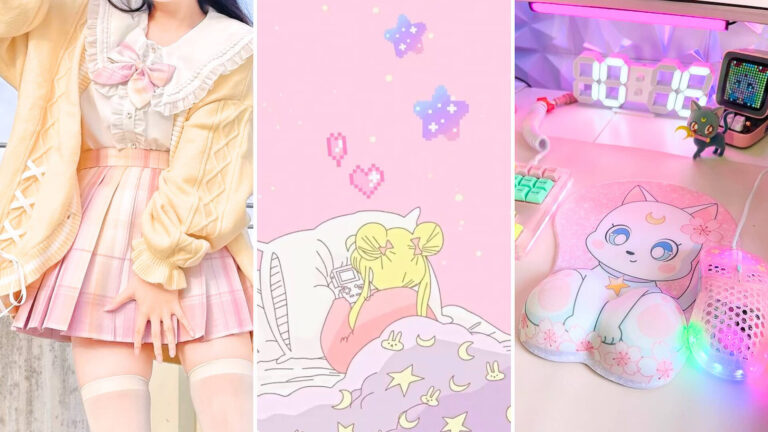
The Kawaii Aesthetic is characterized by its visually pleasing and cute elements that have become synonymous with Japanese culture. This aesthetic is influenced by various factors, including pop culture, fashion trends, and consumer products.
One of the key visual characteristics of Kawaii is the use of pastel colors. Soft shades of pink, blue, and yellow dominate Kawaii fashion and design, creating a dreamy and whimsical atmosphere. These pastel hues are not only visually appealing but also evoke a sense of innocence and purity.
Cute cartoon character prints play a significant role in the Kawaii Aesthetic. Adorable characters, such as Hello Kitty, Pikachu, and Doraemon, are often featured on clothing, accessories, and consumer products. These characters have chubby cheeks, big eyes, and exaggerated features, making them irresistibly cute and appealing.
Hearts, stars, and rainbows are popular motifs in the Kawaii Aesthetic. They are often incorporated into clothing designs, accessories, and even everyday objects. These whimsical elements add a touch of magic and happiness to the overall visual appeal of Kawaii.
The Kawaii Aesthetic encompasses a wide range of visual elements, from pastel colors to cute cartoon character prints, hearts, stars, and rainbows. These visual elements, along with the influence of Japanese pop culture and fashion trends, contribute to the charm and popularity of the Kawaii Aesthetic.
Kawaii Aesthetic Fashion and Outfits Guide
When it comes to Kawaii Aesthetic fashion, the focus is on embracing all things cute and playful. From pastel colors to adorable character prints, Kawaii fashion is all about creating a look that is sweet, whimsical, and incredibly charming. In this fashion guide, we will explore the key elements that define the Kawaii Aesthetic and provide tips on how to incorporate them into your outfits.
Kawaii Clothing
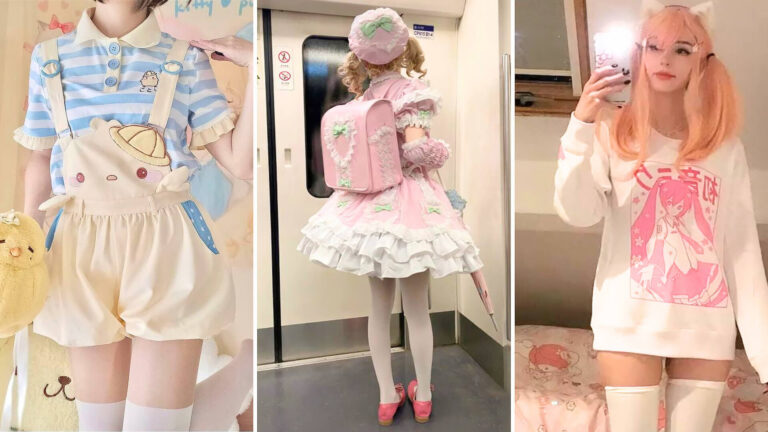
Kawaii clothing is an essential component of the Kawaii Aesthetic, which has become a significant influence in Japanese fashion trends. Characterized by its adorable and playful nature, Kawaii clothing embraces a range of elements that make it distinct.
One prominent feature of Kawaii clothing is the use of pastel colors. Soft shades of pink, blue, mint green, and lavender dominate the Kawaii fashion scene, creating a delightful and dreamy atmosphere. These pastel hues can be found in various clothing pieces like dresses, skirts, and tops, as well as in accessories such as bows, hair clips, and handbags.
Furthermore, Kawaii fashion incorporates cute details that add an extra touch of charm. Think bows, stars, hearts, and playful prints that bring a whimsical element to outfits. Additionally, Kawaii clothing often features beloved anime characters like Hello Kitty, Pikachu, and Totoro, which instantly infuse outfits with a sense of fun and nostalgia.
Kawaii fashion encompasses various popular styles, including the renowned Harajuku fashion and the Sweet Lolita subculture. Harajuku style embraces a mix-and-match approach, combining vibrant colors and creative layering to create unique and eye-catching outfits. Sweet Lolita, on the other hand, embraces a more Victorian-inspired design with frills, lace, and doll-like accessories.
You can find more Kawaii clothing and accessories in our Kawaii Outfits Collection.
Try our new Aesthetic Outfits AI to try on Clothes.
Kawaii Accessories
Kawaii Accessories play a significant role in completing the Kawaii aesthetic, adding an extra touch of cuteness and personality to outfits. There is a wide range of accessories that fall under the Kawaii umbrella, including hairclips, glasses, shoes, socks, necklaces, belts, and bags.
Hairclips are a must-have accessory in the Kawaii world. They come in a variety of shapes and designs, from bows and flowers to adorable animal characters. These hairclips not only keep hair in place but also add a playful and whimsical element to hairstyles.
Glasses can also be an accessory in themselves, with frames featuring cute and unique patterns, such as hearts or stars. They provide both style and function, giving any Kawaii outfit an intellectual and fashionable twist.
Shoes are another important accessory in the Kawaii fashion scene. Pastel-colored sneakers or platform shoes adorned with cute characters or bows reflect the playful nature of the aesthetic.
Socks are often embellished with lace trims, ruffles, or adorable animal faces, adding a touch of charm to any outfit. These socks can be paired with skirts or dresses, peeking out to create a visually appealing look.
Necklaces, belts, and bags are all accessories that can elevate a Kawaii outfit. They come in various designs and feature elements like bows, hearts, or pastel colors, contributing to the overall cute and adorable vibe.
Some popular examples of Kawaii accessories include bow hairclips, heart-shaped glasses, pastel sneakers with playful prints, lace-trimmed socks with cute animal faces, bow necklaces, and pastel-colored backpacks adorned with adorable characters. These accessories not only enhance the Kawaii aesthetic but also make the wearer stand out in a crowd, expressing their love for all things cute and charming.
Kawaii Makeup

Achieving a kawaii aesthetic is not limited to just clothing and accessories. To truly embrace the kawaii culture, makeup plays a significant role. Kawaii makeup focuses on creating a youthful and cute look, with an emphasis on big and bright eyes. Here are the steps to achieve a kawaii makeup look:
- Bright Eyeliner: Start by applying a bright-colored eyeliner, such as pink, blue, or lavender, on the upper lash line. This pop of color will instantly draw attention to your eyes and give them a playful and vibrant appearance.
- White Eyeshadow: Apply a shimmery white eyeshadow on the inner corners of your eyes and on the brow bone. This technique enhances the size and brightness of your eyes, making them look more doll-like.
- Bold Eyeliner: Create a thick and defined line with black eyeliner on the upper lash line. Extend the line slightly beyond the outer corner of your eye to create a subtle winged effect.
- Mascara: Apply a generous coat of mascara to your upper and lower lashes. This will further enhance the doe-eyed look and make your eyes appear bigger and more expressive.
- Pink Blush: Use a soft and pink blush to add a flushed and youthful look to your cheeks. Apply it to the apples of your cheeks and blend it outwards for a natural and rosy glow.
- Gradient Lips: Achieve a cute and pouty lip look by creating a gradient effect. Apply a lighter shade of pink or coral lipstick to the center of your lips and blend it towards the edges. This creates a soft and doll-like appearance.
To add extra kawaii touches, you can also draw cute shapes or fake freckles on your face using a fine-tipped eyeliner pen. Remember, the key to kawaii makeup is to keep it cute, youthful, and vibrant, embracing the core elements of the kawaii aesthetic.
Kawaii Hairstyles
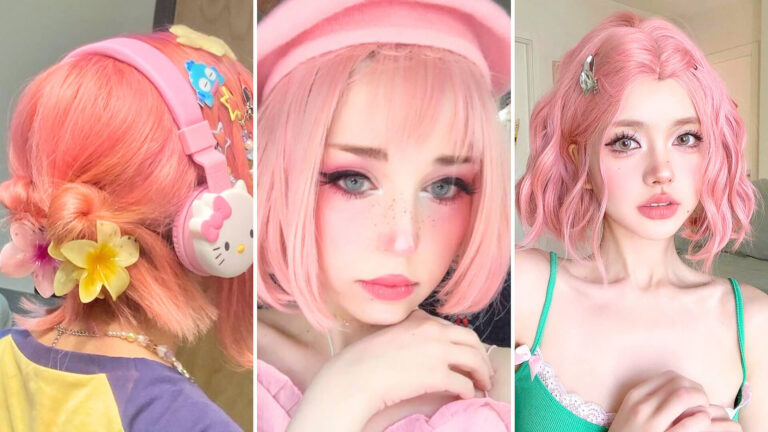
Kawaii hairstyles are an integral part of achieving the adorable and playful kawaii aesthetic. From vibrant hair colors to whimsical hairstyles, there are numerous options to express your kawaii style through your hair.
One popular aspect of kawaii hairstyles is the use of pastel colors. From cotton candy blues to soft lavender and baby pink, these dreamy shades add a touch of fantasy to your look. Underlights, highlights, and split-dye techniques are commonly used to incorporate these enchanting colors into your hair.
In terms of haircuts and styles, kawaii fashion embraces a wide range of options. For short hair, cute and versatile cuts like the pixie cut or bob can be infused with playful elements such as bangs or funky layers. Medium-length hair can be styled into charming space buns, dip-dyed for a touch of whimsy, or adorned with twin braids for a youthful appearance. Long hair allows for gorgeous Hime hairstyles, with cascading curls and intricate braids.
Accessorizing your kawaii hairstyle is essential to complete the look. Hair scrunchies in pastel hues, cute hair ties adorned with bows or fruit-shaped charms, ribbons, and fluffy hairbands are popular choices among kawaii enthusiasts. These accessories add a charming and girlish touch to your hair, enhancing the kawaii aesthetic.
With kawaii hairstyles, you can express your creativity and reflect the cute culture in your own unique way. Embrace the vibrant colors, playful cuts, and adorable accessories to achieve the ultimate kawaii look.
Kawaii Nails and Nail Art
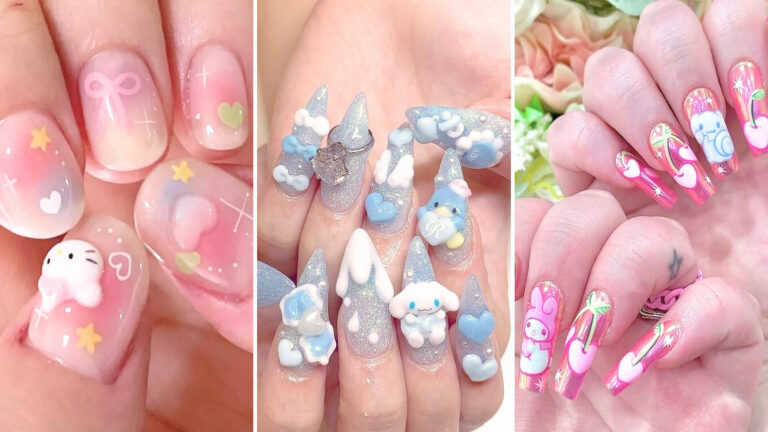
Kawaii nail art is a popular style within the Kawaii aesthetic, allowing individuals to express their creativity and personality through their nails. There are various styles and techniques that can be used to achieve Kawaii nail art, creating adorable and eye-catching designs.
One popular technique is using pastel colors, which are a hallmark of Kawaii fashion. Soft shades such as baby pink, lavender, and mint green are commonly used to create a sweet and dreamy look. Additionally, vibrant colors like bubblegum pink and sunny yellow can also be incorporated for a playful touch.
Kawaii nail art designs often feature cute and whimsical elements. Nail artists often create adorable characters like unicorns, bunnies, or kittens on their nails. Other popular designs include hearts, stars, rainbows, and sweets. These designs are often combined with intricate details such as polka dots, stripes, or bows to enhance the overall cuteness factor.
To create Kawaii nail art at home, you will need a few essential tools and supplies. Nail polish in a variety of colors is a must-have, as well as nail art brushes for detailed designs. Stickers and gems can be used to add extra flair and dimension to your nails. Kawaii nail accessories such as bows, flowers, or glitter can also be incorporated for a fun and girly look.
Tips on How to Create Your Kawaii Outfit
When it comes to creating your kawaii outfit, there are a few key steps and considerations to keep in mind. The kawaii aesthetic is all about embracing cuteness and incorporating elements of Japanese culture. Here are some tips to help you achieve your perfect kawaii look.
First and foremost, start with your color palette. Pastel colors are a must-have for creating a kawaii outfit. Think light pinks, baby blues, and soft yellows. These soft hues set the tone for a sweet and dreamy look.
Next, consider the prints and fabrics of your clothing. Cute prints like floral patterns, polka dots, or cartoon characters can instantly add a kawaii touch. Delicate fabrics like lace and bows also add to the overall aesthetic. Consider items such as plaid skirts, kitten-printed dresses, and oversized hoodies to fully embrace the kawaii style.
Accessories play a big role in completing a kawaii outfit. Think Hello Kitty earrings, long socks with cute prints, and transparent backpacks adorned with stickers or charms.
To enhance the kawaii aesthetic, don’t forget about makeup and beauty. Opt for natural yet youthful makeup looks. Consider using enlarged lenses for a doll-like effect and kawaii eyelashes to make your eyes appear larger and more playful.
Creating a kawaii outfit is all about embracing cuteness and having fun with your style. Remember to incorporate pastel colors, cute prints, delicate fabrics, and add accessories that complete the look. With these tips, you’ll be well on your way to creating your perfect kawaii outfit.
Impact of Kawaii Aesthetic on Fashion
The Kawaii Aesthetic has had a significant impact on fashion in Japan, revolutionizing and redefining traditional styles. One prominent example is the Lolita fashion trend, which incorporates elements of Victorian-era clothing with a cute and youthful twist. With its frilly dresses, lace accessories, and doll-like makeup, Lolita fashion embodies the kawaii aesthetic and has gained immense popularity among fashion enthusiasts.
Another style influenced by the Kawaii Aesthetic is Decora fashion, characterized by its vibrant and colorful look. Decora fashion embraces an abundance of accessories, including bows, beads, and toys, creating a playful and eye-catching appearance. This kawaii-inspired style has transformed unconventional fashion trends into cute and vibrant styles, allowing individuals to express their individuality while staying true to the kawaii culture.
Japanese clothing companies are known for their incorporation of cute details and anime characters into their products. From t-shirts adorned with adorable cartoon characters to accessories inspired by popular manga series, these companies cater to the kawaii fashion trend and the love for all things cute in Japanese popular culture. This fusion of fashion and anime creates a unique and captivating look for those who embrace the kawaii aesthetic.
Various other kawaii fashion trends can be found in Japan, including cosplay, Harajuku fashion, sweet Lolita, kawaii gothic, and decora. Cosplay allows individuals to dress up as their favorite anime, manga, or video game characters, showcasing their love for kawaii culture. Harajuku fashion is a mix of different kawaii styles, featuring bold prints, unique silhouettes, and vibrant colors. Sweet Lolita focuses on a more feminine and cute look, with pastel colors, bows, and lace, while kawaii gothic combines elements of darkness with the adorable kawaii aesthetic. Decora, as mentioned earlier, emphasizes accessorizing and creating a bold and colorful appearance.
Kawaii Aesthetic in Art and Pop Culture
The Kawaii Aesthetic has had a significant impact on art and pop culture, particularly in Japan but with an increasing global influence. This whimsical and playful style has infiltrated various artistic mediums, from fashion to music to entertainment.
In the realm of fashion, the Kawaii Aesthetic has inspired a multitude of trends. Japanese street fashion, such as Harajuku fashion, embraces the cuteness and innocence associated with kawaii. This style encompasses bright colors, oversized bows, and cutesy prints. Kawaii fashion has also made its mark in the mainstream, with many Western designers incorporating pastel colors and cute motifs into their collections.
In the music industry, artists like Kyary Pamyu Pamyu have become synonymous with the Kawaii Aesthetic, with their catchy tunes and fantastical music videos. These artists embody the essence of kawaii with their colorful costumes, adorable dance moves, and childlike innocence.
Furthermore, the Kawaii Aesthetic has made its way into the entertainment world, influencing anime, manga, and video games. Characters in these mediums often have big, expressive eyes, chubby cheeks, and exaggerated features, all of which are central to the kawaii style. The popularity of Kawaii characters, such as Hello Kitty and Pikachu, has reached global proportions, showcasing the universal appeal of this aesthetic.
The Kawaii Aesthetic has become deeply entrenched in Japanese society, permeating various aspects of life. It reflects the broader emphasis on cuteness and finding joy in the small things. This cultural influence extends beyond Japan’s borders, with Kawaii gaining traction worldwide, attracting fans who appreciate its adorable and uplifting qualities.
Kawaii Style in Music & Entertainment
Kawaii style has had a significant impact on the music and entertainment industry, particularly in Japan and South Korea. With its emphasis on cuteness and innocence, Kawaii has influenced the rise of J-pop and K-pop, two genres characterized by their catchy tunes and vibrant visual elements.
In the music industry, Kawaii elements can be seen in music videos, stage performances, and album artwork. Artists like Kyary Pamyu Pamyu and Babymetal have become icons of the Kawaii aesthetic, with their whimsical costumes, playful choreography, and adorable personas. These musicians embody the essence of Kawaii, captivating audiences with their infectious energy and childlike charm.
Furthermore, Kawaii style has seamlessly integrated into TV shows, movies, and animated films. Characters with big, expressive eyes, pastel colors, and cute mannerisms have become staples of these productions, attracting a wide fanbase both locally and internationally. The Kawaii influence can be seen in popular animated series like “Sailor Moon” and “Kimi no Na wa” (Your Name), as well as in live-action adaptations like “Parfait Tic!” and “Love Live!“.
Kawaii Aesthetic in Interior Design
The kawaii aesthetic extends beyond video games and permeates other areas of Japanese culture, including interior design. One key aspect of kawaii interior design is the use of pastel colors. Soft shades of pink, blue, and lavender create a sweet and gentle ambiance, while also infusing spaces with a sense of playfulness.
Cute motifs like hearts, rainbows, and stars are also commonly incorporated into kawaii-inspired interiors. These simple and whimsical shapes add a touch of cheerfulness and childlike innocence to the space. Additionally, nature-inspired elements such as cherry blossoms and fluffy clouds enhance the overall kawaii aesthetic, bringing elements of the outdoors inside.
When it comes to food, the kawaii aesthetic is evident through the decoration and presentation of dishes. Fruits and vegetables are often carved or arranged into adorable shapes, while desserts are adorned with pastel-colored sprinkles and cute candies. Character-shaped bento boxes are also popular, transforming traditional Japanese lunches into playful and eye-catching meals.
Future of the Kawaii Aesthetic Beyond 2024
The kawaii aesthetic has already made a significant impact on various industries, but its influence is expected to continue to grow and evolve beyond 2024. In fashion, we can anticipate a further embrace of kawaii elements, such as pastel colors, cute characters, and playful prints. The popularity of kawaii fashion subcultures like fairy kei and lolita fashion may also continue to rise, and we may see the emergence of new kawaii styles.
In the art world, the kawaii aesthetic is likely to continue to inspire artists, with more emphasis on whimsical and cute themes. Pop culture, especially in Japan, will continue to be heavily influenced by kawaii characters and imagery, with a focus on creating lovable and relatable fictional characters.
In music, we may see more kawaii-inspired genres emerging, combining catchy melodies with adorable lyrics and visuals. Virtual idol and virtual YouTuber culture, which already incorporates kawaii elements, may become even more mainstream.
Video games will also be influenced by the kawaii aesthetic, with more adorable and charming characters incorporated into gameplay. We may see the rise of kawaii-themed mobile games, bringing cute and addictive gameplay experiences to a wider audience.
In interior design, the kawaii aesthetic may continue to be popular, with a focus on creating spaces that evoke a sense of comfort and cuteness. Expect to see more kawaii-inspired home decor and furniture, with pastel colors and cute patterns taking center stage.
Overall, the future of the kawaii aesthetic beyond 2024 holds endless potential for growth and expansion. As it continues to evolve, it will likely leave an even more significant mark on fashion, art, pop culture, music, video games, and interior design.
